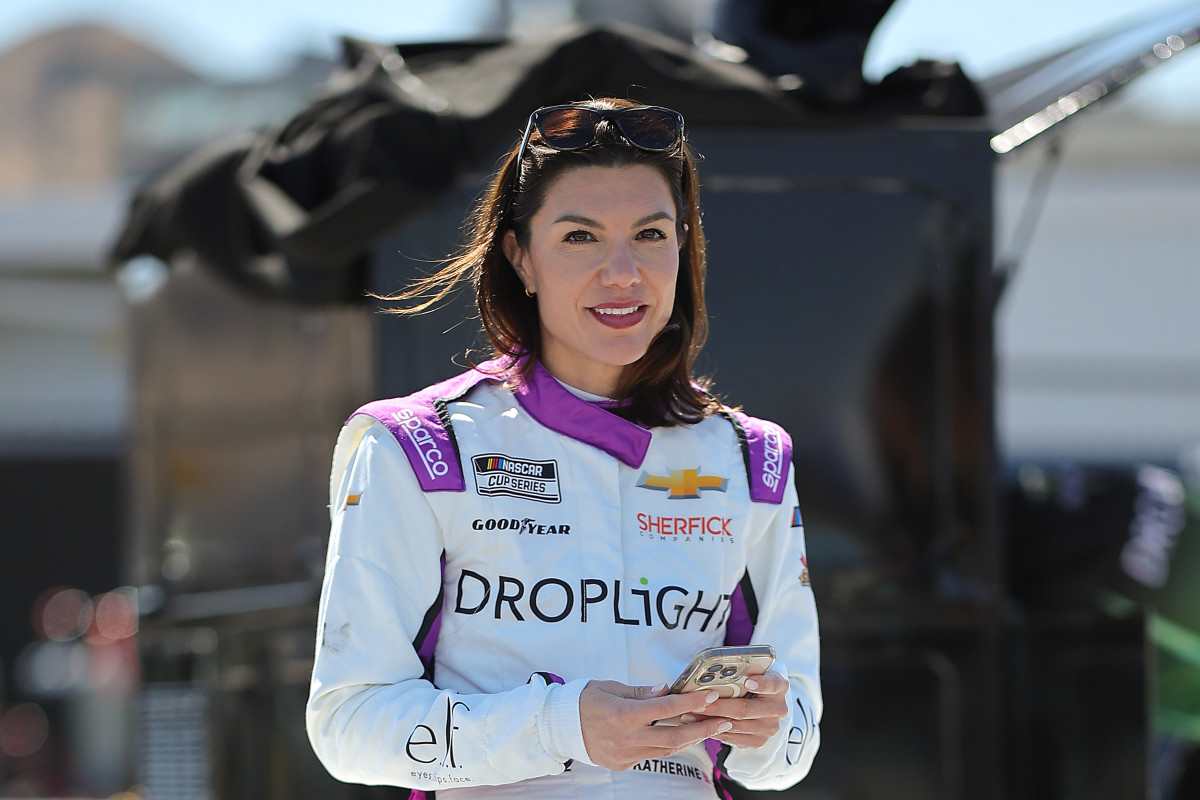When you think about the fast-paced, high-octane world of stock car racing, it's easy to picture roaring engines and daring drivers pushing limits. For many, this sport brings to mind a long history filled with speed and competition. Yet, there is a special part of this story that often gets a little less attention, the very first women who dared to take on the track. It's a tale of breaking through and showing everyone what was possible, so it's almost a story about grit and determination.
People sometimes wonder about the early days of NASCAR, specifically about who might have been the first woman to compete. It's a good question, as a matter of fact, because the sport was quite different back then. The racing scene was, you know, a place where women were not typically found behind the wheel of a powerful stock car, not in the way men were, anyway.
This article will pull back the curtain on that piece of history, uncovering the person who first put her name on the list of NASCAR competitors. We will, in some respects, look at her beginnings, the racing world she entered, and the lasting mark she left on a sport that was just starting to get its big break.
- What Happened To Lisa On The Bay
- Actors With Long Black Hair
- Quote About Nostalgia
- Joey And Kariselle Now
- Pics Of Jessica Caban
Table of Contents
- Biography of Sara Christian, A Pioneer
- What Was the Racing Landscape Like for Who Was The First Female NASCAR Driver?
- Early Days and First Steps for Who Was The First Female NASCAR Driver
- How Did Sara Christian Make Her Mark as Who Was The First Female NASCAR Driver?
- Beyond Sara Christian - Other Women Who Followed
- What Challenges Did Early Female Drivers Face in NASCAR?
- The Legacy of Who Was The First Female NASCAR Driver
- Who Was The First Female NASCAR Driver - What Does It Mean Today?
Biography of Sara Christian, A Pioneer
When we talk about the first woman to race in NASCAR, we are talking about Sara Christian. She was a person who really stepped up and showed courage at a time when things were very different for women in sports. Her story is one of quiet determination, basically, and a real love for speed. She certainly made a name for herself in the early days of stock car racing.
Sara Christian was born in 1918, in Dahlonega, Georgia. That area, you know, was a place where car racing, especially with modified stock cars, was already quite popular. Dirt tracks were common, and folks would gather to watch drivers push their cars to the limit. It was a kind of homegrown sport, really, and she grew up right in the middle of it all.
Her connection to racing came through her husband, Frank Christian, who was also a racer and later a car owner. It was, in a way, through him that she got her initial exposure to the competitive side of things. She had a knack for driving, and it became pretty clear she wasn't just a passenger or a spectator. She had a genuine talent for handling a vehicle, and that's something you just can't teach.
- Rosemarie Fritzl Still Alive
- Dynasty Actors
- Joel Michael Singer
- Thats So Raven Cartoon
- Paige Bueckers Dating
She was, like, a regular person who found herself drawn to a very unusual hobby for a woman of her time. Her willingness to get behind the wheel and compete against men, often in cars that were not exactly easy to handle, speaks volumes about her character. She really broke some new ground, you know, for women who might have wanted to race.
Personal Details and Bio Data of Sara Christian
| Full Name | Sara Williams Christian |
| Born | August 29, 1918 |
| Birthplace | Dahlonega, Georgia, USA |
| Died | October 7, 1980 |
| Spouse | Frank Christian |
| NASCAR Debut | June 19, 1949 (Charlotte Speedway) |
| NASCAR Races Started | 6 (Grand National/Cup Series) |
| Career Best Finish | 5th (1949 Pittsburgh, PA) |
| Notable Achievements | First woman to compete in a NASCAR race; First woman to earn a top-five finish in a NASCAR race. |
What Was the Racing Landscape Like for Who Was The First Female NASCAR Driver?
The world of stock car racing in the late 1940s was, honestly, a rough and tumble affair. NASCAR itself was just getting started, having been formed by Bill France Sr. in 1948. Before that, racing was often a more disorganized thing, with different rules and tracks across the country. It was, you know, a bit wild west in its feel.
Most of the drivers were men, many of whom had learned their skills running moonshine during Prohibition. These were tough guys, often with a lot of experience driving fast on back roads. The cars were, basically, modified production models, not the custom-built machines we see today. They were heavy, hard to steer, and often pretty dangerous, too.
The tracks themselves were mostly dirt ovals, which meant a lot of dust, sliding, and unpredictable conditions. Spectators would gather, sometimes in huge numbers, to see the excitement. It was a very physical sport, and the idea of a woman competing in this kind of environment was, well, pretty unusual, to say the least. There just weren't many women doing it, in fact.
For someone like who was the first female NASCAR driver, entering this scene meant going against a lot of expectations. Society at the time had very clear ideas about what women should and should not do. Racing a car at high speeds against a field of men was definitely outside the usual boundaries, so it was a big deal.
Early Days and First Steps for Who Was The First Female NASCAR Driver
Sara Christian's moment came on June 19, 1949, at the Charlotte Speedway in North Carolina. This was the very first race for NASCAR's new "Strictly Stock" division, which would later become the Cup Series we know today. It was a truly historic day for the sport, and, you know, she was a part of it.
She wasn't the only woman at that race, as a matter of fact. Louise Smith and Ethel Mobley, who was Sara's sister-in-law, also competed. However, Sara Christian holds the distinction of being the first woman to actually start a NASCAR-sanctioned race. That's a pretty big deal, really, when you think about it.
Her entry into the race was, perhaps, a bit spontaneous. Her husband, Frank, was supposed to drive the car, but he apparently felt a little under the weather. So, Sara stepped in. She had driven cars before, of course, and had some experience with speed. This wasn't just a whim; she had a genuine ability to handle a car.
The race itself was, you know, a tough one. The track was a three-quarter-mile dirt oval, and the cars were not easy to control. Despite the challenges, Sara Christian managed to finish in 14th place out of 33 starters. That was a pretty respectable showing for anyone, let alone someone making history as who was the first female NASCAR driver.
Her participation, basically, opened a lot of eyes. It showed that women could indeed compete in a sport that many considered to be exclusively for men. This one race, in a way, set the stage for other women to follow, proving that the track was not just a place for one gender.
How Did Sara Christian Make Her Mark as Who Was The First Female NASCAR Driver?
Sara Christian's career in NASCAR was, admittedly, brief, but it was certainly impactful. After that first race in Charlotte, she went on to compete in five more races during the 1949 season. She didn't win any of them, but her performances were, you know, noteworthy, especially considering the circumstances.
Her best finish came at the Dayton Speedway in Ohio, where she placed sixth. Even more impressive was her fifth-place finish at the Pittsburgh, Pennsylvania, race later that year. Achieving a top-five finish in a NASCAR race, particularly in that era, was a very big accomplishment for any driver, let alone who was the first female NASCAR driver. It showed she wasn't just there to participate; she was there to compete.
She also made history by being the only woman to compete in the first three NASCAR Strictly Stock races. This consistency, in a way, helped solidify her place in the record books. She proved that her debut was not a one-off event but rather a real commitment to the sport. She truly earned her spot, as a matter of fact.
Her participation was, basically, a quiet statement. She didn't seek out a lot of fanfare or attention. She just wanted to race. By simply being there and performing well, she created a kind of ripple effect. She showed that the door could be opened for others, and that's something that really mattered.
Her presence on the track, you know, challenged the traditional views of racing. It made people think a little differently about who could be a race car driver. She wasn't just a driver; she was, in some respects, a symbol of change, even if she didn't set out to be one.
Beyond Sara Christian - Other Women Who Followed
While Sara Christian holds the title of who was the first female NASCAR driver, she was not alone in breaking barriers. Other women, some of whom she raced alongside, also made their own marks in the early days of stock car racing. These women, too, had a love for speed and a determination to compete.
Louise Smith, often called "The First Lady of Racing," was another prominent figure. She was known for her aggressive driving style and, honestly, for crashing quite a bit. But she always got back in the car. She competed in 11 races in 1949 and had three top-ten finishes. Her spirited approach really captured the attention of fans, and that's something that made her stand out.
Ethel Mobley, Sara Christian's sister-in-law, also raced in the 1949 season. She competed in four races, showing that racing talent ran in the family, basically. These women, together, formed a small but significant group that helped pave the way for future female drivers. They were, in a way, a small band of pioneers.
Over the years, other women would come and go, some making more of a splash than others. Drivers like Shawna Robinson, Patty Moise, and later Danica Patrick would continue to challenge the male-dominated field. Each of them, in their own time, built upon the foundation laid by those early racers like who was the first female NASCAR driver.
Their stories are, you know, a testament to persistence and a refusal to be limited by expectations. They showed that passion for racing knows no gender. It's about the skill, the nerve, and the desire to go fast, and that's something these women clearly had.
What Challenges Did Early Female Drivers Face in NASCAR?
Being a female race car driver in the late 1940s and early 1950s was, without a doubt, a very tough path. The challenges were, you know, many, and they went beyond just the difficulties of racing itself. There were societal hurdles, too, that women had to deal with every single day.
One of the biggest challenges was simply acceptance. Many people, including some male drivers and fans, believed that racing was not a suitable activity for women. There were, basically, a lot of old-fashioned ideas about what women should be doing. So, just showing up and competing was, in a way, a form of protest.
The physical demands of the sport were also a major hurdle. Early stock cars had no power steering, no air conditioning, and very little in the way of safety features. Driving them for hours on a hot, dusty track required immense strength and stamina. Women had to prove they were just as capable as men, and that's something they did, often under tough conditions.
Finding equipment and support could also be a problem. Sponsorships were rare, and teams were often small operations. For who was the first female NASCAR driver and others, getting a good car and a reliable crew could be a real struggle. They often had to rely on family or their own money to keep racing, which was a tough situation.
Media attention, when it came, was often focused on their gender rather than their driving skill. Headlines would often emphasize "woman driver" rather than their performance. This could be, you know, a bit frustrating for someone who just wanted to be seen as a racer, pure and simple.
Despite all these difficulties, these early female drivers kept going. Their determination to race, even when faced with skepticism and hardship, speaks volumes about their passion for the sport. They truly loved racing, and that's what kept them pushing forward.
The Legacy of Who Was The First Female NASCAR Driver
The impact of Sara Christian, as who was the first female NASCAR driver, goes far beyond her individual race results. Her participation, and that of other early women racers, created a kind of opening for future generations. She showed that the track was not just for men, and that's something that truly matters.
Her story is, in a way, a quiet reminder that breaking barriers often starts with just one person doing something different. She didn't make a huge fuss, but her actions spoke louder than any words could. She simply got in the car and raced, and that was enough to make a difference, basically.
The fact that she earned a top-five finish in a NASCAR race is, you know, a significant achievement that should not be overlooked. It proved that she wasn't just a novelty; she was a legitimate competitor who could hold her own against the best drivers of her time. That's a pretty strong statement, really.
Her legacy is about courage and persistence. It's about showing up when no one expects you to, and performing well even when the odds are stacked against you. She set a precedent that said, "Yes, women can do this too." That's a powerful message that still resonates today, as a matter of fact.
For many female drivers who came after her, Sara Christian's story, even if they didn't know all the details, was part of the history that made their own journeys possible. She helped lay the groundwork for a more inclusive sport, and that's something that deserves to be remembered.
Who Was The First Female NASCAR Driver - What Does It Mean Today?
Thinking about who was the first female NASCAR driver, Sara Christian, and her journey helps us understand the path that women in motorsports have traveled. Her early efforts set a kind of foundation for the women who now compete at various levels of racing, from local tracks to the biggest stages.
Today, we see women like Hailie Deegan and Toni Breidinger competing in NASCAR's national series. While they still face their own set of challenges, the landscape is very different from Sara Christian's time. There are more opportunities, more support systems, and a greater acceptance of women in racing, which is good.
The story of who was the first female NASCAR driver reminds us that progress is often built step by step. Each woman who has strapped into a race car, from Sara Christian onward, has contributed to changing perceptions and opening doors. It's a continuous process, basically, of showing what's possible.
Her quiet strength and determination continue to inspire. It tells us that sometimes, the most profound changes come from simply doing what you love, even if it goes against the grain. Her story, you know, is a testament to the power of individual action in a big way.
So, when we watch races today and see women competing, it's good to remember those who came before. Sara Christian was a true pioneer, a woman who showed the world that a race car doesn't care about gender, only about skill and nerve. Her contribution to the sport, in some respects, truly set the stage for a more diverse future.
This article has explored the life and impact of Sara Christian, the first female NASCAR driver, looking at her biography, the early racing environment, her significant achievements, and the challenges faced by women in early NASCAR. We also considered the legacy she left behind and what her pioneering spirit means for the sport today, providing a picture of a truly remarkable individual who helped shape the history of stock car racing.
Related Resources:



Detail Author:
- Name : Claud Blick
- Username : damaris83
- Email : xwilderman@mclaughlin.com
- Birthdate : 1978-07-20
- Address : 37729 Pearlie Centers Suite 398 Kilbackland, NJ 96947
- Phone : (646) 875-3932
- Company : Glover-Rice
- Job : Postal Service Clerk
- Bio : Consequuntur totam cumque eos quibusdam inventore. Atque similique hic quas vel pariatur laborum. Vitae voluptate ut sit eum et. Molestias explicabo consequatur totam illum sequi repellendus.
Socials
linkedin:
- url : https://linkedin.com/in/oma.reinger
- username : oma.reinger
- bio : Est placeat fuga occaecati.
- followers : 4943
- following : 2580
twitter:
- url : https://twitter.com/oma.reinger
- username : oma.reinger
- bio : Sit laudantium quidem dolorum aut. Repellat eos vitae animi libero praesentium enim perspiciatis. Saepe et sint reiciendis voluptatum nostrum vel.
- followers : 5749
- following : 831